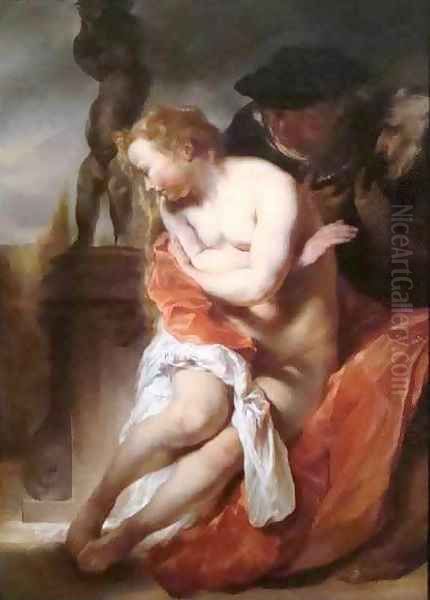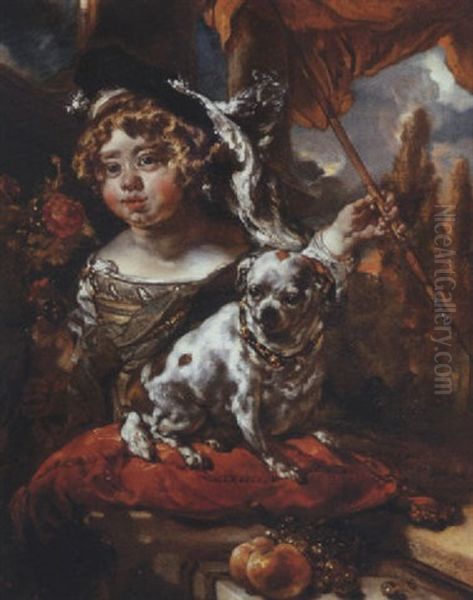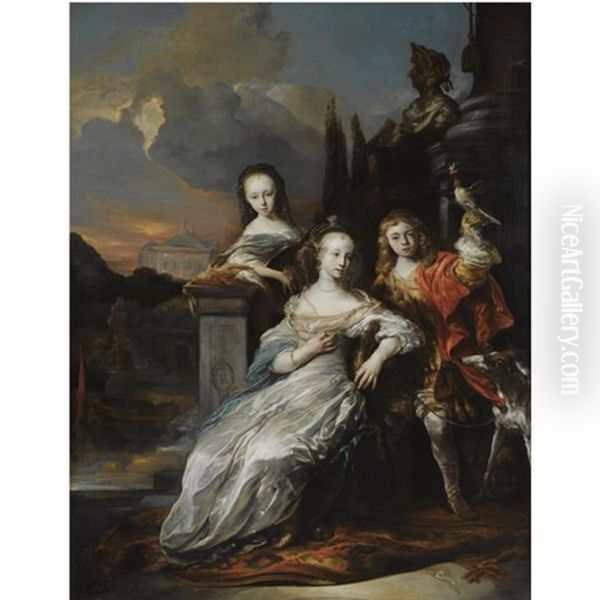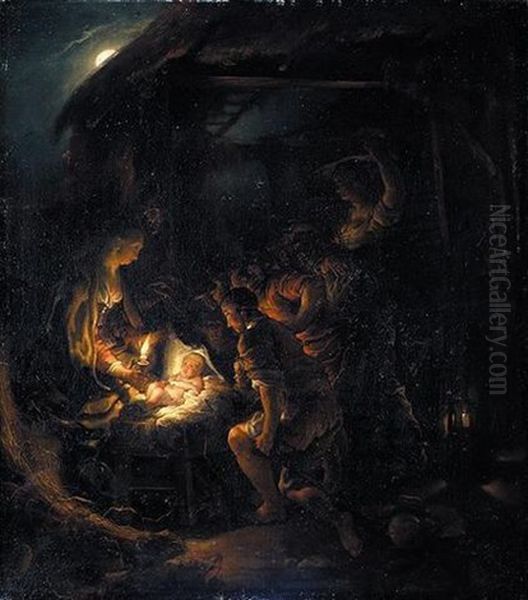
The Dutch Golden Age, spanning roughly the 17th century, remains one of the most fertile and celebrated periods in the history of Western art. While names like Rembrandt, Vermeer, and Hals often dominate popular consciousness, the era was populated by a vast constellation of talented painters, each contributing to the rich tapestry of artistic production. Among these, Jan van Noordt (circa 1623/24 – after 1676) stands as a compelling figure, an artist of considerable skill whose true stature has only more recently been appreciated, thanks in large part to dedicated art historical research that has rescued him from relative obscurity and the shadow of misattribution. Active primarily in Amsterdam, Van Noordt specialized in history paintings and portraits, creating works characterized by their vibrant color, dynamic compositions, and a distinctive blend of Dutch and Flemish influences.
Early Life and Artistic Formation in Amsterdam
Precise details about Jan van Noordt's early life remain somewhat elusive, a common challenge when studying artists from this period for whom documentation can be sparse. He is believed to have been born around 1623 or 1624, likely in Amsterdam, the bustling metropolis that served as the economic and cultural heart of the Dutch Republic. This city, with its thriving art market and diverse population of patrons and painters, would have provided a stimulating environment for an aspiring artist.
A crucial aspect of Van Noordt's early development was his apprenticeship. Scholarly consensus, notably advanced by art historian David A. DeWit, points to Jacob Adriaensz Backer (1608/09–1651) as Van Noordt's master. Backer was himself a prominent Amsterdam painter, renowned for his elegant portraits and ambitious history paintings. He was known for his fluid brushwork, sophisticated use of color, and an ability to imbue his subjects with a sense of refined grace. Training under Backer would have exposed Van Noordt to a high level of technical proficiency and a style that successfully blended local Dutch traditions with broader European, particularly Flemish, currents. This tutelage undoubtedly laid a strong foundation for Van Noordt's own artistic endeavors, which commenced in earnest around 1645. His early output included not only paintings but also etchings, demonstrating a versatility in different artistic media.
The Development of a Distinctive Style: Influences and Innovations

Jan van Noordt’s artistic style is a fascinating synthesis of various influences, primarily drawing from the robust energy of the Flemish Baroque, yet filtered through a distinctly Dutch sensibility. The towering figures of Peter Paul Rubens (1577–1640) and Anthony van Dyck (1599–1641) cast a long shadow over European art, and their impact is discernible in Van Noordt's work. He clearly admired the dynamism, rich color palettes, and dramatic intensity characteristic of Rubens and his circle. This is evident in the often-theatrical staging of his narrative scenes and the vigorous portrayal of his figures.
Another significant Flemish artist whose influence can be traced in Van Noordt's paintings is Jacob Jordaens (1593–1678). Jordaens, known for his boisterous genre scenes and robust mythological and religious paintings, shared with Rubens a love for vibrant color and energetic compositions. Van Noordt seems to have absorbed this Flemish predilection for lively, full-bodied figures and a certain earthy realism, even when depicting lofty historical or biblical subjects. Some scholars have even described aspects of Van Noordt's style as reflecting a "more primitive, coarser Rubensian style," suggesting an interpretation of Rubens's grandeur that was perhaps less polished but no less powerful in its directness.
Despite these strong Flemish undercurrents, Van Noordt was not a mere imitator. He skillfully integrated these influences with the prevailing artistic trends in Amsterdam. His work demonstrates a remarkable command of color, often employing striking contrasts—such as rich reds, golds, greens, and blues—to heighten the visual impact and emotional resonance of his compositions. His figures, while often imbued with a Rubensian vitality, also possess a psychological depth and individuality that aligns with Dutch artistic concerns. He paid meticulous attention to the rendering of textures, particularly in fabrics, jewels, and other decorative elements, showcasing a technical finesse that appealed to the discerning tastes of his clientele.
Themes and Genres: History, Mythology, and Portraiture
Jan van Noordt’s oeuvre encompasses the principal genres popular during the Dutch Golden Age, with a particular emphasis on history painting and portraiture. History painting, which included biblical scenes, mythological episodes, and allegorical subjects, was considered the most prestigious genre, allowing artists to demonstrate their erudition, compositional skills, and ability to convey complex narratives and emotions.

Van Noordt excelled in this demanding field. His biblical scenes often depict moments of high drama or profound human emotion. Works like Susanna and the Elders showcase his ability to handle multi-figure compositions and convey narrative tension. The story, popular in art, allowed for the depiction of virtue under threat and divine justice, themes that resonated with contemporary audiences. Similarly, The Massacre of the Innocents, now housed in the Statens Museum för Konst in Stockholm, is a powerful and moving interpretation of a tragic biblical event, demonstrating his capacity for conveying pathos and drama on a grand scale. Another notable biblical work is The Levite and his Concubine at Gibeah, a subject rarely depicted that highlights Van Noordt's willingness to tackle less common narratives.
Mythological subjects also provided fertile ground for Van Noordt's imagination. Jupiter and Mercury with Philemon and Baucis (1672), located in the Sinebrychoff Art Museum, Helsinki, is a fine example. This painting illustrates the Ovidian tale of hospitality rewarded by the gods, and Van Noordt uses the subject to explore contrasts, such as the divine and the mortal, the courtly and the rustic. The rich depiction of textures, from the golden embroidery on a princess-like figure's costume to the humble setting of the elderly couple, showcases his technical skill and eye for detail.
Portraiture was another significant aspect of Van Noordt's output. In an era where a growing affluent class sought to immortalize themselves and their families, portrait painters were in high demand. Van Noordt’s portraits, such as the compelling Portrait of a Boy with a Falcon, reveal his ability to capture not only a likeness but also a sense of the sitter's personality and status. The inclusion of attributes like the falcon adds layers of meaning, often alluding to nobility, training, or youthful pursuits. Other works, like Boy's Portrait and Girl with a Dog, further attest to his skill in capturing the innocence and character of young sitters.
Key Representative Works
Several paintings stand out as particularly representative of Jan van Noordt's artistic achievements and stylistic characteristics.
Susanna and the Elders is a subject Van Noordt tackled, and it remains one of his well-known history paintings. The narrative, derived from the Book of Daniel, depicts the virtuous Susanna being accosted by two lecherous elders while bathing. Van Noordt’s interpretation typically emphasizes the vulnerability of Susanna and the predatory nature of the elders, using dramatic lighting and expressive figures to convey the emotional intensity of the scene. His handling of flesh tones and rich drapery would be characteristic of his mature style.

The Massacre of the Innocents is a powerful and ambitious composition. This biblical episode, recounting King Herod's order to kill all male infants in Bethlehem, is inherently tragic and violent. Van Noordt’s rendition would likely focus on the chaos, despair, and brutality of the event, using dynamic figure groups and strong emotional expressions to engage the viewer. The painting’s presence in a major public collection like the Statens Museum för Konst underscores its significance.
Jupiter and Mercury with Philemon and Baucis (1672) is a masterful example of his mythological work. The painting beautifully illustrates the theme of humble virtue rewarded. Van Noordt’s skill in rendering diverse textures – the shimmering fabrics of the gods contrasted with the simpler attire of the mortals, the gleaming vessels versus rustic earthenware – is on full display. The composition likely balances the divine visitors with their elderly hosts, creating a scene that is both intimate and imbued with a sense of wonder. The use of contrasting colors and a clear, organized composition would be typical of his approach.
Portrait of a Boy with a Falcon exemplifies his talent in portraiture. Such works were not merely about capturing a likeness but also about conveying status and character. The falcon, a symbol often associated with nobility and the education of young gentlemen, adds a layer of iconographic richness. Van Noordt would have focused on the boy's expression, the texture of his clothing, and the careful rendering of the bird, creating an engaging and individualized portrayal.
Other significant works that contribute to our understanding of his range include A Mary with the Infant Jesus and the Young John the Baptist, an early piece that might show the initial formation of his style, and paintings like Esther's Toilet, Rest on the Flight into Egypt, St. John the Evangelist, and Woman with a Basket of Grapes, each showcasing different facets of his thematic interests and artistic capabilities.
The Challenge of Attribution and Scholarly Reassessment
One of the most intriguing aspects of Jan van Noordt's legacy is the long period during which many of his works were misattributed to other, often more famous, artists. This is not uncommon for painters who did not consistently sign their works or whose biographical details faded into obscurity over time. Stylistic similarities, particularly his assimilation of Rubensian and Rembrandtesque elements, led to his paintings being ascribed to figures like Peter Paul Rubens himself, or to artists within Rembrandt van Rijn's (1606–1669) circle, such as Govert Flinck (1615–1660) or Ferdinand Bol (1616–1680).

The meticulous research undertaken by art historians, most notably David A. DeWit, has been instrumental in rectifying these misattributions and reconstructing Van Noordt's oeuvre. Through systematic stylistic analysis, comparative study, and the examination of technical details, DeWit and others have been able to confidently reassign a significant body of work to Van Noordt. This process of scholarly detective work has not only expanded our knowledge of Van Noordt's output but has also shed new light on the complex web of artistic influences and workshop practices in 17th-century Amsterdam. The re-evaluation of Van Noordt's contributions has enriched our understanding of the diversity and quality of painting during the Dutch Golden Age, revealing him as an artist of considerable talent who deserves recognition in his own right.
Van Noordt in the Context of His Contemporaries
Jan van Noordt operated within one of history's most vibrant and competitive art scenes. Amsterdam in the mid-17th century was teeming with painters, each vying for commissions and seeking to establish their reputation. His teacher, Jacob Backer, was a significant figure, but the artistic landscape was dominated by the towering presence of Rembrandt van Rijn. While Van Noordt was not a direct pupil of Rembrandt, the latter's innovative approach to composition, dramatic use of chiaroscuro, and profound psychological insight influenced virtually every artist working in Amsterdam. Some of Van Noordt's works, with their rich impasto and expressive intensity, may reflect an awareness of Rembrandt's powerful style, which could partly explain some of the past misattributions.
Other prominent contemporaries in Amsterdam included Bartholomeus van der Helst (1613–1670), a highly successful portraitist known for his polished, detailed, and elegant depictions of the city's elite. Van der Helst’s smooth finish and emphasis on social representation offered a contrast to the more painterly and often more dramatic approach of artists like Van Noordt or those closer to Rembrandt.
Painters like Govert Flinck and Ferdinand Bol, both of whom did study with Rembrandt before developing their own more classically inclined or elegant styles, were also key figures. Their career trajectories, moving from a Rembrandtesque idiom towards a lighter, more internationally fashionable manner, reflect the shifting tastes of Dutch patrons. Van Noordt’s adherence to a more robust, somewhat Flemish-influenced style set him apart, though he was clearly capable of adapting to a range of commissions.

Beyond history painters and portraitists, Amsterdam was home to masters of other genres. Landscape painters like Jacob van Ruisdael (c. 1628–1682) captured the Dutch countryside with unparalleled atmospheric depth, while genre painters like Pieter de Hooch (1629–1684), who was active in Amsterdam for part of his career, meticulously depicted scenes of domestic life. Even artists working in different specializations contributed to the overall artistic ferment of the city. Figures like Gerrit van Honthorst (1592–1656), though primarily associated with Utrecht and known for his Caravaggesque night scenes and later courtly portraits, also had an impact on the broader Dutch art scene. The presence of so many talented individuals created an environment of intense competition but also of shared learning and stylistic exchange, from which Van Noordt undoubtedly benefited and to which he contributed.
Later Years and Enduring Legacy
Information regarding Jan van Noordt's later life is, much like his early years, somewhat scarce. It is believed that he left Amsterdam around 1675. The reasons for his departure are not definitively known, but some historical accounts suggest that he may have encountered financial difficulties, possibly leading to debt. This was not an uncommon fate for artists, even successful ones, in an era where the art market could be volatile and personal fortunes could change rapidly. His death is recorded as occurring sometime after 1676.
For centuries, Jan van Noordt remained a relatively minor figure in art historical narratives, his name often overshadowed and his works frequently absorbed into the oeuvres of others. However, the dedicated efforts of modern scholarship have brought about a significant reassessment. By carefully disentangling his paintings from those of his more famous contemporaries and by analyzing his unique stylistic synthesis, art historians have revealed Jan van Noordt as an artist of considerable originality and skill.
His ability to fuse the dramatic energy of the Flemish Baroque with Dutch sensibilities, his mastery of color and composition, and his insightful portrayals of historical, mythological, and human subjects mark him as an important contributor to the richness of the Dutch Golden Age. His representative works, such as Susanna and the Elders, The Massacre of the Innocents, and Jupiter and Mercury with Philemon and Baucis, stand as testaments to his artistic vision. The rediscovery of Jan van Noordt not only adds another significant name to the roster of Dutch masters but also deepens our appreciation for the complexity and diversity of art produced during this remarkable period. His journey from relative obscurity to renewed recognition highlights the ongoing dynamism of art history and its capacity to uncover and celebrate forgotten talents.